Budapest
Top-Rated Tourist Attractions in Budapest
Budapest, the capital of Hungary and considered by many to be the "Paris of the East," is one of the most culturally important metropolises in Eastern Europe, and is home to numerous UNESCO World Heritage Sites. Although humans have lived here since the Stone Age, this beautiful city only formally came into being in 1872 with the amalgamation of three previously independent towns-Old Buda (Óbuda), Buda, and Pest-to become the administrative, commercial, and industrial center of Hungary.
Straddling the River Danube, Budapest is famous for its thermal springs, some of which have been used for therapeutic purposes since prehistory. In fact, Budapest has so many things to do that you'll want to spend at least a few days exploring this dynamic city. Popular attractions range from impressive architecture and poignant reminders of 20th-century history to its vibrant cultural and entertainment scene, with everything from street buskers to classical concerts in beautiful churches.
Budapest is also a shopper's paradise, from the traditional wares and foodstuffs available at the Central Market Hall to Vaci Street, noted for its mix of luxury boutique stores and big brand names. Whatever your sightseeing preferences, get the most out of your Hungary travel itinerary with our guide to the top tourist attractions in Budapest.
1. Buda Castle & Castle Hill
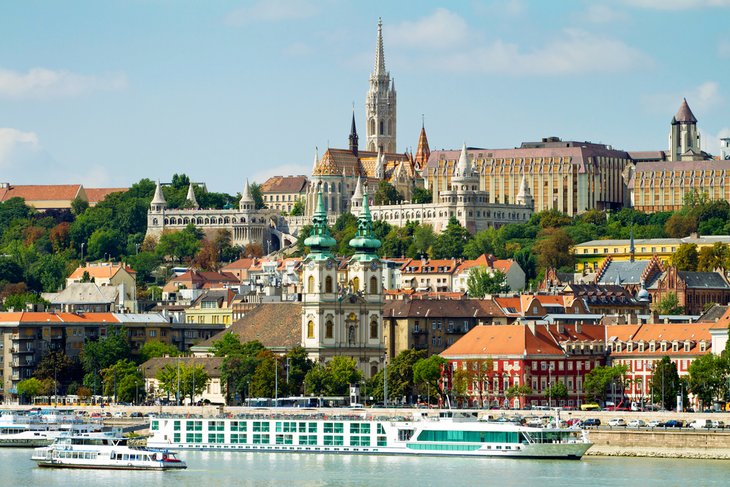
Towering over the Danube, Budapest's Castle Hill (Várhegy) contains many of the city's most important medieval monuments and museums. Topping the list of these impressive structures is the 18th-century Buda Castle (Budavári Palota), a massive 200-room palace that replaced a 13th-century castle built to protect the stronghold from Mongol and Tartar attacks.
Although badly damaged in World War II, much of the exterior has been restored, along with sections of the interior, which now houses a number of important museums. These include the Hungarian National Gallery in the main wing, while in the south wing, the Budapest History Museum occupies four floors.
In front of the castle, overlooking the Danube, stands a bronze equestrian statue of Prince Eugene of Savoy, a hero of Turkish attacks on the city. Castle Hill is worth exploring for its medieval lanes and it Romanesque, Gothic, and Baroque architecture. This entire historic complex is a UNESCO World Heritage Site.
Like much of the city, Buda Castle is spectacularly illuminated at night, and the castle courtyards remain open 24 hours a day. You can reach the castle on the restored historic Castle Funicular Railway, which departs from the Buda end of the Chain Bridge.
2. Hungarian Parliament Building & Crown Jewels
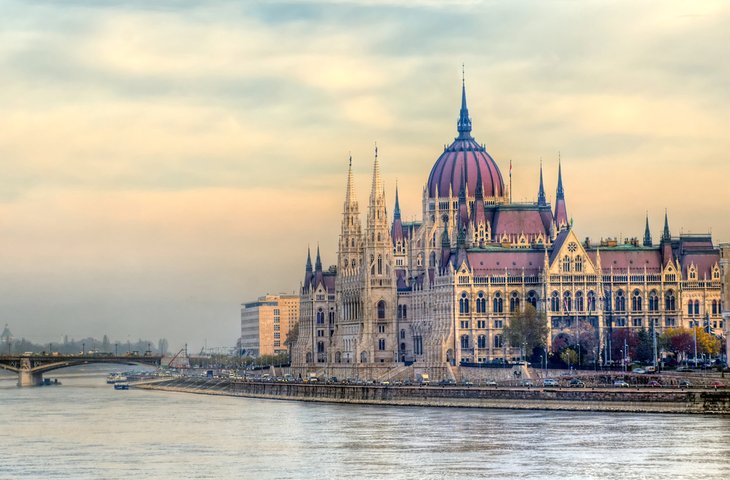
A highlight of a walk around Budapest's lovely pedestrian-friendly cobbled streets is the area around the country's architecturally pleasing Parliament building (Országház), along with its neighbors, the Museum of Ethnography and the Ministry of Agriculture.
The world's third largest parliament building, this Neo-Gothic building was inaugurated in 1886 to mark the country's 1,000th anniversary. (Hungary was then part of the Austro-Hungarian Empire.)
This impressive structure boasts 691 rooms, as well as an impressive 19 kilometers of corridors and stairs. Guided tours last approximately 45 minutes and are available whenever the government is not sitting, and include many of the building's highlights, such as the main entrance hall, various lobbies, and the Hungarian Crown Jewels.
3. St. Stephen's Basilica
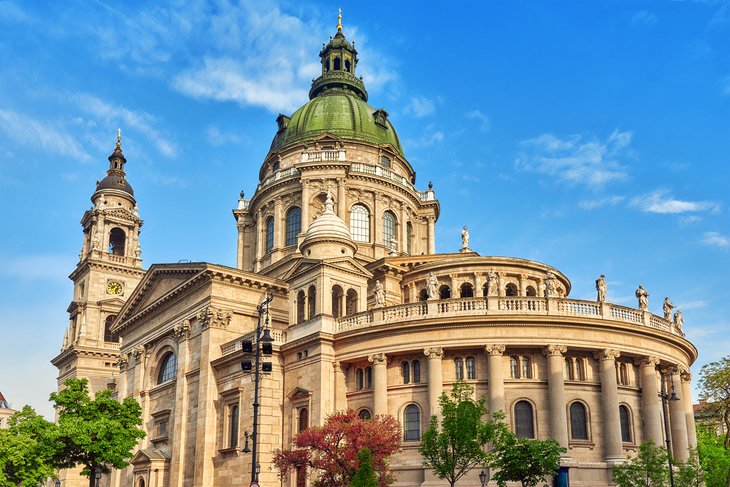
Budapest's St. Stephen's Basilica (Szent István-bazilika) is a popular attraction for its impressive architecture, the beauty of its interior, and the panoramic views from its dome. The cathedral is dedicated to St. Stephen, Hungary's holy king and the founder of the Hungarian state, and construction began in 1851, but after several construction setbacks-including the collapse of its unfinished dome-it was not dedicated until 1905.
The roof, towers, and external walls were badly damaged in World War II, and the church's precious mosaics fell from the walls. However, these were successfully restored to their original place and are the highlight of the richly decorated interior. The most impressive of these, the five-part Venetian mosaic is in the sanctuary and represents the allegories of the mass.
The cathedral's most precious holy relic, the mummified right hand of the church's patron saint, the first king of Hungary, is displayed under glass in the chapel to the left of the high altar.
One of the best things to do here, if time permits, is to take one of the two elevators that carry visitors up to the cupola for sweeping 360-degree views over the city and the Danube (alternatively, you can climb the 364 steps). Guided tours of the basilica are available on weekdays. Also, be sure to check the cathedral's website for details of one of its frequent organ and classical music concerts.
4. Fisherman's Bastion
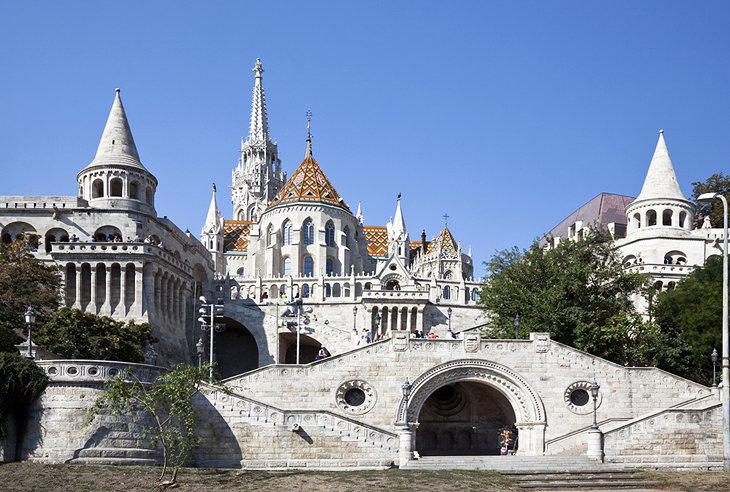
Overlooking the Danube, on the spot where the city's fishermen's guild built their defence walls in the Middle Ages, stands the impressive Fisherman's Bastion (Halászbástya). This exquisite collection of Neo-Romanesque towers, courtyards, colonnades, and walls was built between 1895 and 1902, and is one of the most popular points in the city for tourists, largely for its spectacular views over the city and the Danube.
While here, be sure to look for the bronze equestrian statue of St. Stephen, the first King of Hungary, in the south courtyard. The reliefs on the sides of the base depict scenes from Stephen's life, and make for an incredible selfie backdrop. A variety of English language tour options are available.
5. The Danube Promenade
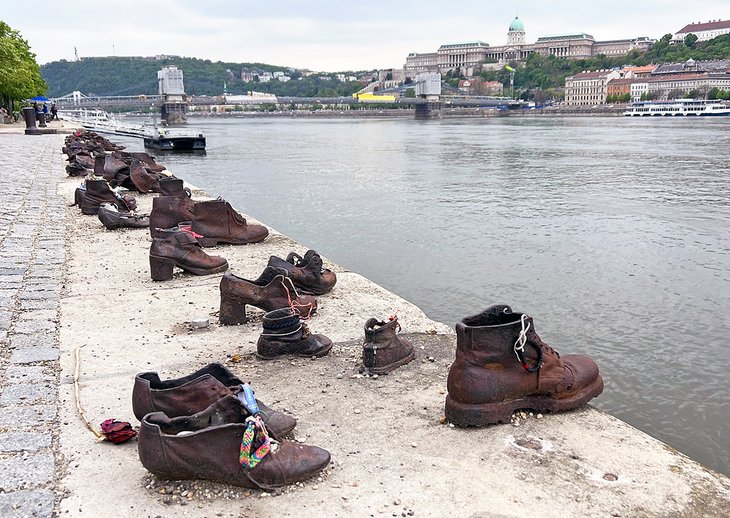
The Danube (or "Duna" in Hungarian) flows through Budapest from north to south, and in some places within city boundaries is as much as 640 meters wide. One of the top free things to do in Budapest is strolling along the Danube Promenade (Dunakorzó), a pleasant century-old riverside walk that extends between the Elisabeth and Széchenyi Chain Bridges.
Although there are many places from which to enjoy views of the majestic river as you stroll its banks (either the Buda or Pest sides, they're both good), the Danube Promenade is definitely one of the best vantage points to take in views of the city's stunning architecture.
It's also on the banks of the Danube (the northeast side, close to the Hungarian Parliament buildings) that you'll find the chilling Shoes on the Danube Bank memorial, a series of 60 pairs of steel sculpted shoes commemorating Jews shot here by the Nazis. It's a poignant and moving reminder of the Nazi atrocities suffered by Hungary in World War II.
Another great way to view the city is via a boat cruise along the Danube. Numerous tourist excursions depart regularly from the landing stages at Vigadó tér on the Pest bank and Bem József tér on the Buda bank, and are highly recommended. It's also fun watching these sturdy vessels from the historic Freedom Bridge as they whip down river only to have to struggle back against the current.
6. Matthias Church (Church of Our Lady)
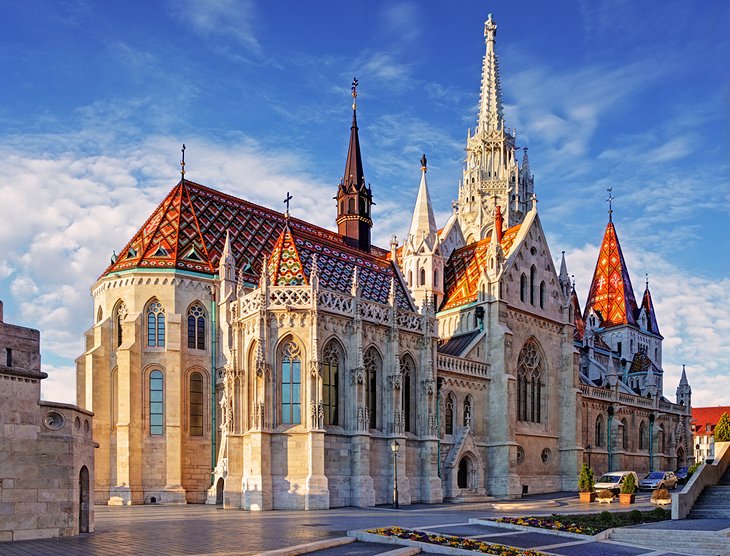
Matthias Church, also known as The Church of Our Lady (Nagyboldogasszony-templom), is a prominent landmark on Castle Hill. It was completed in 1269, and its magnificent south doorway with its relief depicting the Death of Mary was added in the 1300s.
During the Turkish occupation of 1541-1699, the church was used as a mosque, and was later renovated in the Baroque style. It has been the scene of several historic events, including the coronation of King Charles I of Hungary in 1309 and the coronation of Emperor Franz Joseph I of Austria and his consort Elisabeth (Sissy) as rulers of Hungary. It was for this event that Franz Liszt composed his coronation mass.
The free organ concerts held here on Sunday evenings are well worth attending. Also worth checking out, the Ecclesiastical Art Museum is located on the church's medieval crypt and features a collection of sacred relics, stone carvings, and replicas of the Hungarian crown jewels.
7. Exploring Gellért Hill
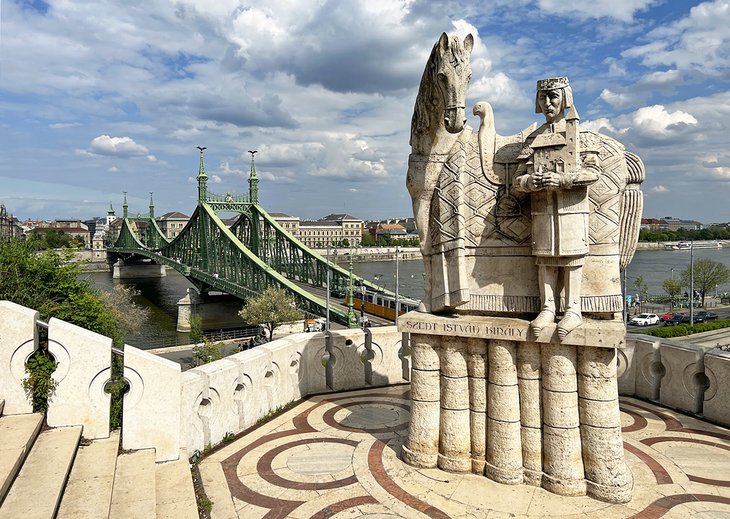
Another of Budapest's most striking features is the panoramic Gellért Hill (Gellért-hegy), a 235-meter block of dolomite that falls steeply down to the Danube. It's here along the hill's geological fault line that several of the city's most famous medicinal springs emerge to supply the Gellért Spa and Rudas Baths, which have lured visitors from far and wide since the 13th century. The Rudas Baths are one of a handful of buildings remaining from the Turkish occupation, and are among the few original Turkish bathhouses in the world still in use that date back to the 1600s.
On the hill's northeast slope is the Gellért Monument, a tribute to Hungary's beloved famous saint, a Benedictine monk who died in 1046 and after whom the hill is named. Perched high above a man-made waterfall, it offers magnificent views over the city. The Citadel on the summit was built by the Austrians in 1851, and the Liberation Monument was erected in 1947 in memory of the Soviet soldiers who died fighting in WWII.
Finally, if you have energy left, take a stroll around Jubilee Park. Laid out to celebrate the 40th anniversary of the October Revolution, it's home to many charming walkways, beautiful flowerbeds, and sculptures. Just across Freedom Bridge from the Gellért Spa is the Great Market Hall, a beautiful sight with its roof of colorful Zsolnay tiles from Pécs, Hungary.
8. The Museum of Fine Arts

The Museum of Fine Arts (Szépmuvészeti Múzeum) is not only Budapest's most important art gallery, it houses one of the largest collections of works by the Old Masters to be found in Europe. The extensive array of Italian, Spanish, and Dutch paintings are on display in a spectacular, classically influenced 19th century building with long rooms for the larger paintings, cabinets for smaller and more intimate items, together with architecturally interesting space such as the Renaissance Hall.
Established in 1870 after Hungary inherited a fine collection of paintings, drawings, and prints, the museum is divided into six excellent departments: Egyptian Art, Ancient Art, the Old Sculpture Gallery, the Old Painter Gallery, the Modern Collection, and the Graphics Collection.
The adjacent Palace of Art is the city's leading contemporary art museum and hosts many temporary exhibits, so be sure to check for current offerings. (Note that this is not to be confused with the Palace of Arts, a high-tech arts center that houses the Ludwig Museum, a contemporary art collection with works by Picasso, David Hockney and numerous Hungarian Masters.)
9. Heroes' Square and the Millennium Monument
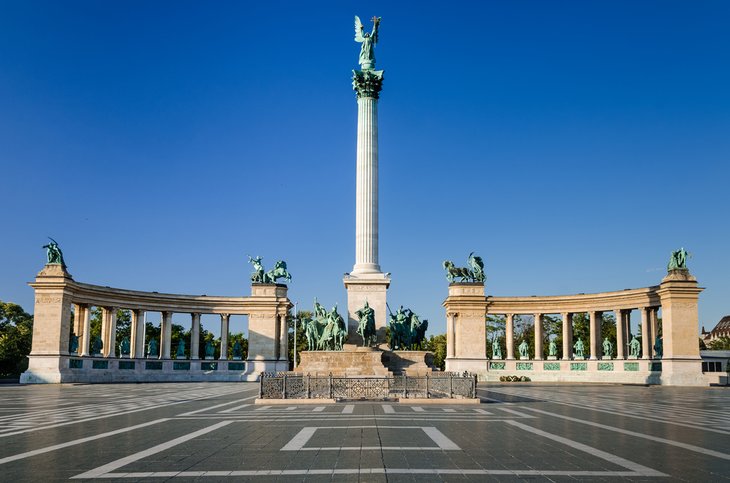
The impressive Heroes' Square (Hosök tere) was largely the work of architect Albert Schickedanz, who was also responsible for the huge Museum of Fine Arts that flanks this large open space.
Highlights include the Millennium Monument, a 36-meter column crowned by a figure of the Archangel Gabriel and unveiled in the late 19th century. Around the plinth can be seen a group of bronze horsemen representing the conquering Magyar Prince Árpád and six of his fellow warriors.
On either side of the column, colonnades extend in a semi-circle, and between the individual pillars stand statues of Hungarian rulers. Above the corner pillars are beautiful works in bronze by Zala.
In front of the Millennium Monument stands a memorial to the Unknown Soldier. It's an especially nice place to visit at night when illuminated.
10. Széchenyi Thermal Bath
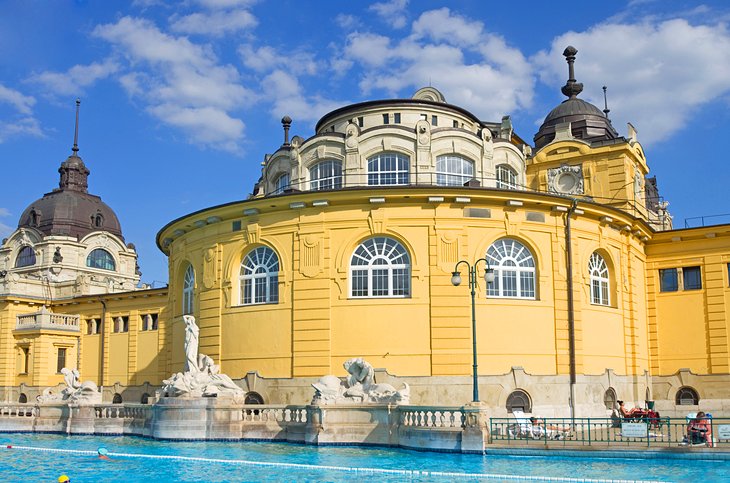
Budapest is well-known worldwide for its incredible thermal springs, many of which have been harnessed to provide citizens, as well as visiting tourists, the opportunity to relax and rejuvenate in thermal baths.
Of the many such attractions Budapest, the best known is Széchenyi Thermal Bath (Széchenyi gyógyfürdo). Established in 1913, it's supplied by two thermal springs; it's also the biggest such facility in Europe, capable of handling thousands of bathers at a time in its three outdoor pools (including an adventure pool that's great for families) and 15 indoor pools.
In addition to its pools, guests can enjoy its saunas and steam rooms, as well as spa services including massages. For a special treat, pay a visit to the baths after nightfall. Day tickets can be purchased on-line, or upon arrival.
11. Hungarian State Opera House
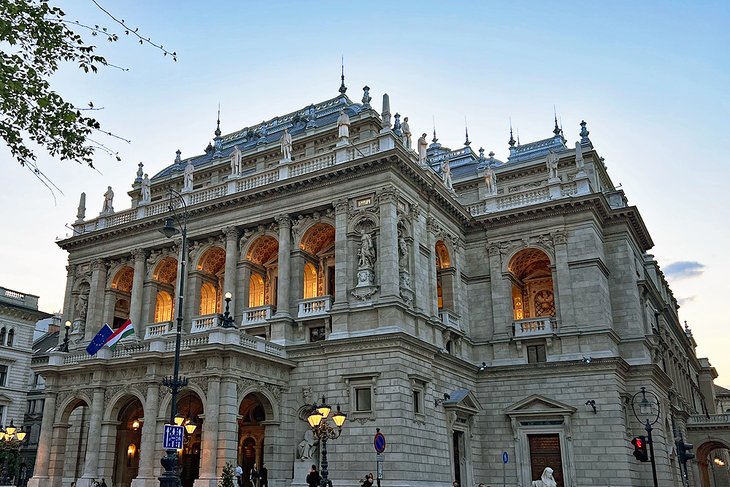
As impressive inside as it is on the outside, the Hungarian State Opera House (Magyar Állami Operaház) is a must-see when in Budapest. The building's dimensions alone are impressive, and since it opened in 1884, it has commanded top spot on the city's cultural events calendar.
As delightful as its many performances (more on that in a minute) is the sumptuous interior of the building. Festooned with wonderful artwork and sculptures from the country's most significant artists, the Opera House can seat 1,261 people in its horseshoe-shaped (and acoustically pleasing) auditorium.
The Hungarian State Opera House is home to the Budapest Philharmonic Orchestra and the Hungarian National Ballet, and you'd certainly find attending a performance a crowning moment in your Budapest travel itinerary. The orchestra's season typically runs from September to June, and tickets can be purchased online. Daily guided English-language tours are also available.
12. Budapest Zoo & Botanical Garden
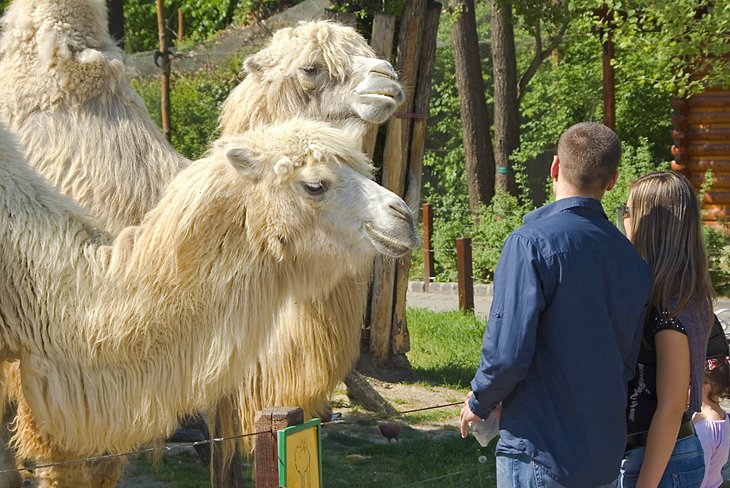
Said to be one of the world's oldest still-operating zoos, Budapest Zoo & Botanical Garden (Fovárosi Állat- és Növénykert) is one of the top things for families to do when visiting the city. Established over 150 years ago, the park is home to over 1,070 different species of animals, and has the rare distinction of being located in the heart of its host city.
In addition to its well-preserved Art Nouveau animal homes, this top-notch zoo park features a nature reserve, themed animal enclosures, and a variety of kid-friendly programming including feeding opportunities. If you're not in a big hurry to leave, hang around for one of the regular evening concerts.
Leading the list of other fun things to do for families in Budapest is paying a visit to the incredibly fun Miniversum Budapest. Though basically a massive model railway setup, this relatively new family attraction features detailed models of major Hungarian landmarks, along with a sprinkling from other European countries, including Germany and Austria. These are all connected by numerous model trains (up to 100 are running at any given time), 1,300 meters of track, and authentic-looking scenery, all made to scale. Fun behind-the-scenes tours are also available.
13. Hospital in the Rock Nuclear Bunker Museum
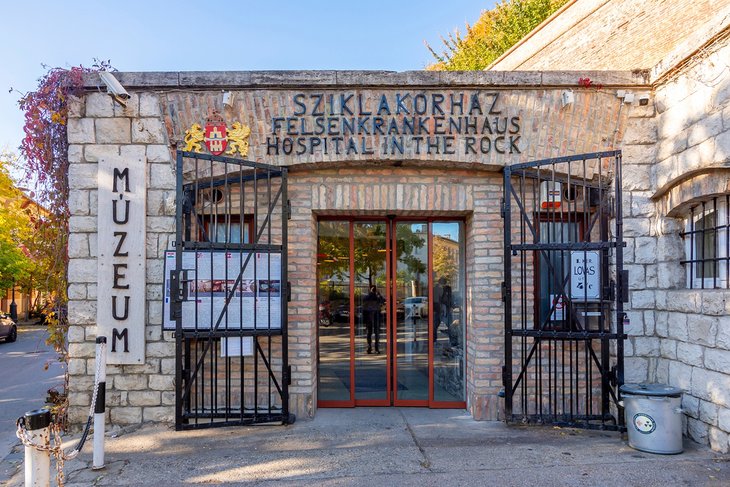
Underneath Castle Hill, the rock is a maze of caves and passageways that have been used for various purposes since prehistoric times. In World War II, some were fortified as an air raid shelter and emergency hospital. Now known as the Hospital in the Rock Nuclear Bunker Museum (SziklakórházAtombunker Múzeum), this site was, at the time of the Cold War, further secured against nuclear contamination.
This former hospital and bunker is well worth exploring and features a variety of exhibitions on the kind of lifesaving efforts seen here during the Siege of Budapest in World War II. Another exhibit explores the devastating consequences of nuclear weapons. Admission is via guided tours only (English language tours available).
14. The University Church
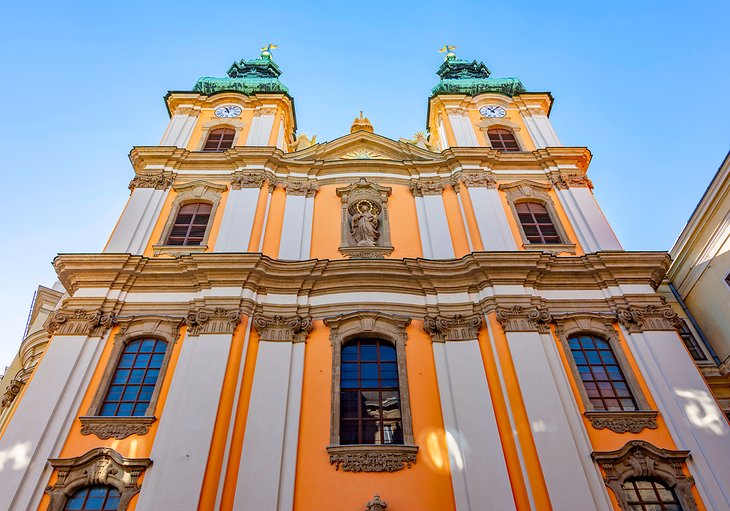
Budapest's University Church (Kisboldogasszony-templom) is widely regarded as the most beautiful Baroque church in the city. Although somewhat hidden-it stands in the south of Pest away from the main shopping streets-its main front faces onto a narrow side street, which scarcely does it justice.
Built between 1725-42 (the two mighty towers were not completed until 1771), the principal façade incorporates a triangular tympanum with representations of St. Paul and St. Anthony, as well as the arms of the Pauline Order (a palm between two lions and a raven).
The church has a single nave with pilasters and enclosed side-chapels, and its walls are clad in artificial marble. Highlights include the frescoes on the barrel-vaulted ceilings depicting scenes from the life of Mary (1776), the choir-stalls, and the sculptures of St. Paul and St. Anthony on the High Altar (1746). Also of note is the Pauline Monastery near the church.
15. Hungarian National Museum
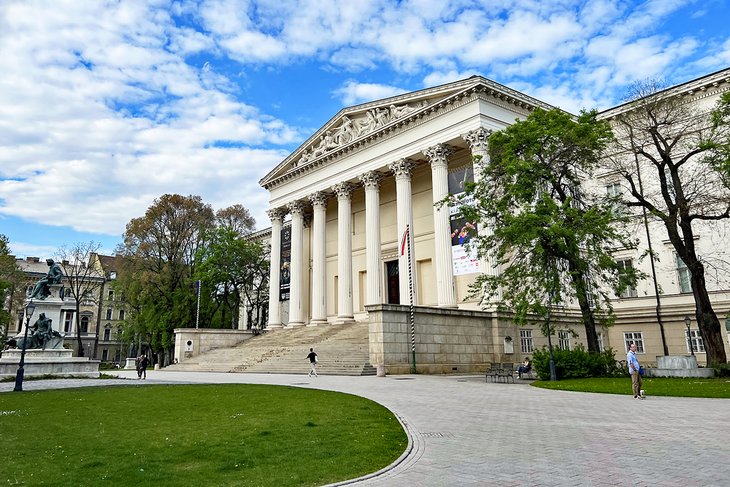
Although founded in 1802, the superb Hungarian National Museum (Magyar Nemzeti Múzeum) didn't move into its current home, a large classical building surrounding two courtyards, until 1847. In addition to its massive portico, a monument to the famous Hungarian poet János Arany impresses, as does its park-like gardens with their numerous busts of famous people.
Major exhibits comprise the Royal Regalia, including the magnificent Crown of St. Stephen with its precious stones and pearls, as well as Hungary's pre- and early history from the Stone Age through to Roman times and the early Middle Ages.
Also of interest are the exhibits and artifacts dealing with the country's many struggles for independence, as well as historic Hungarian and Turkish weapons. For music buffs, Beethoven's grand piano, which later belonged to Franz Liszt, can be seen here.
16. City Park (Városliget)
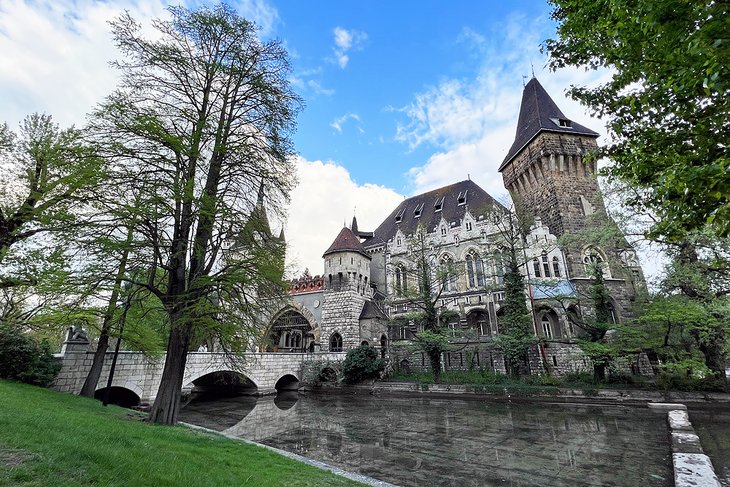
With its pretty lake, the 302-acre heavily wooded City Park (Városliget) is a popular recreational site for both Budapest locals and visitors. Laid out in the 19th century, the park has had many additions over the years.
Sightseeing highlights include the Museum of Fine Arts and the Palace of Art; the Municipal Zoological and Botanical Garden; the excellent Transport Museum of Budapest; Tivoli Pleasure Park, with its kids' rides and arcades; the massive open-air Széchenyi Medicinal Bath; the fairytale Vajdahunyad Castle; and the 100,000-seat People's Stadium.
17. Margaret Island
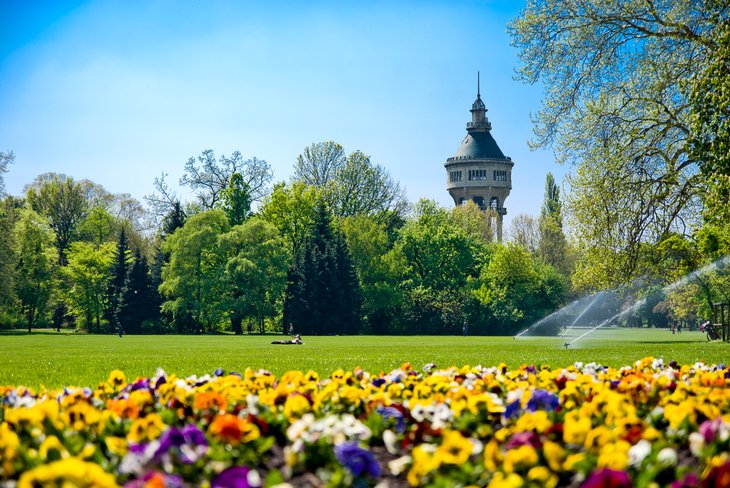
Margaret Island (Margitsziget), barely 2.4 kilometers long and 503 meters wide, is Budapest's main recreation and recuperative center for locals. Thermal spring-fed medicinal baths, carefully tended gardens and paths, as well as the ruins of many historic buildings also serve to attract many tourists, too.
A highlight of any visit is the Palatinus Baths, a huge spa complex that covers more than 17 acres and includes a bath with artificial waves, together with various medicinal, swimming, and children's pools capable of accommodating up to 20,000 bathers at a time.
Other island highlights are the pretty Rose Garden (Rózsakert); the Union Monument, a metal sculpture by István Kiss (1972) in the form of a flower; ruins of the Dominican convent, once home to Princess Margaret, the daughter of King Béla IV; the 51-meter water-tower, built in 1911, with its excellent viewing platform; and a large open-air theater.
Other fun things to do here include bike rentals or enjoying a meal at one of the restaurants here. If visiting at night, be sure to head to the Margaret Island Musical Fountain for its illuminations.
(thanks to: www.planetware.com)
Comments
Post a Comment